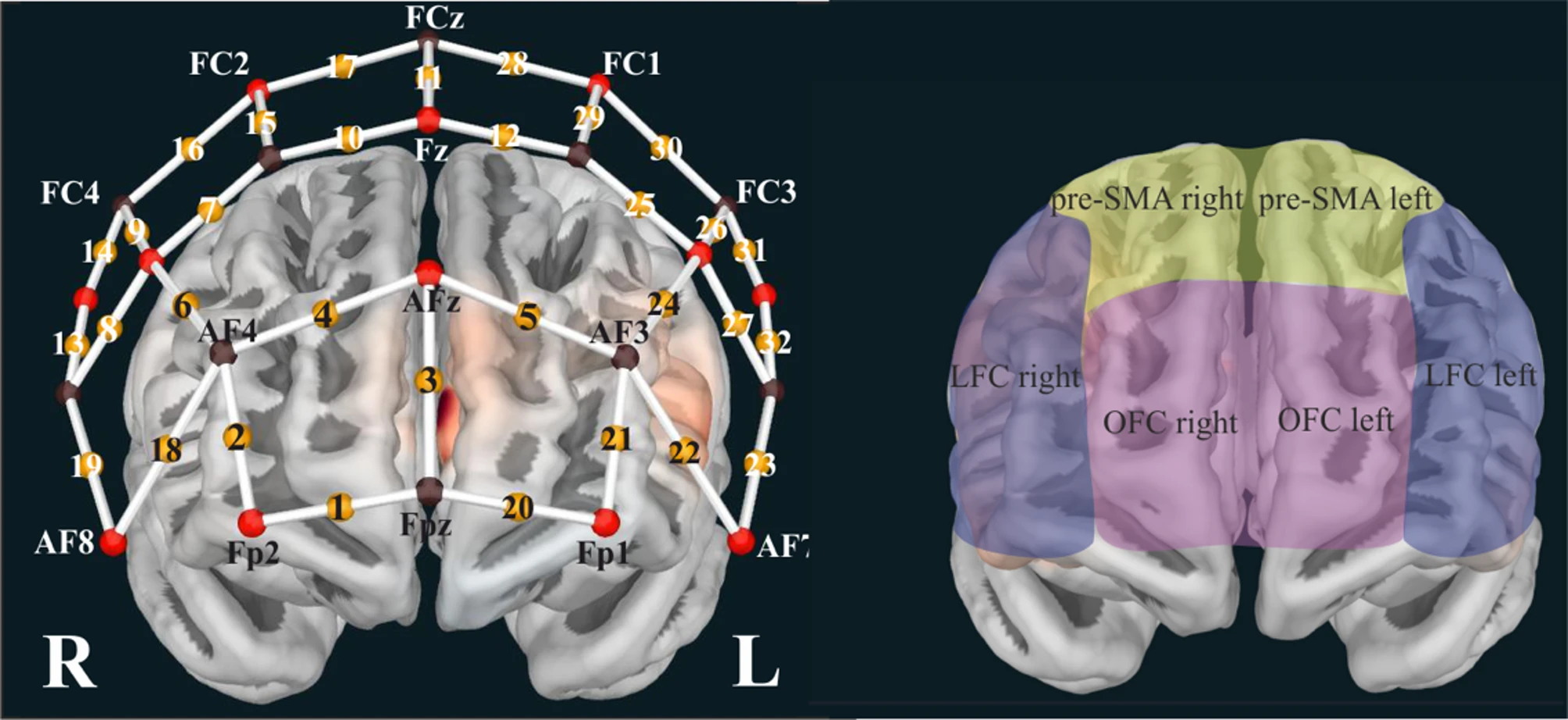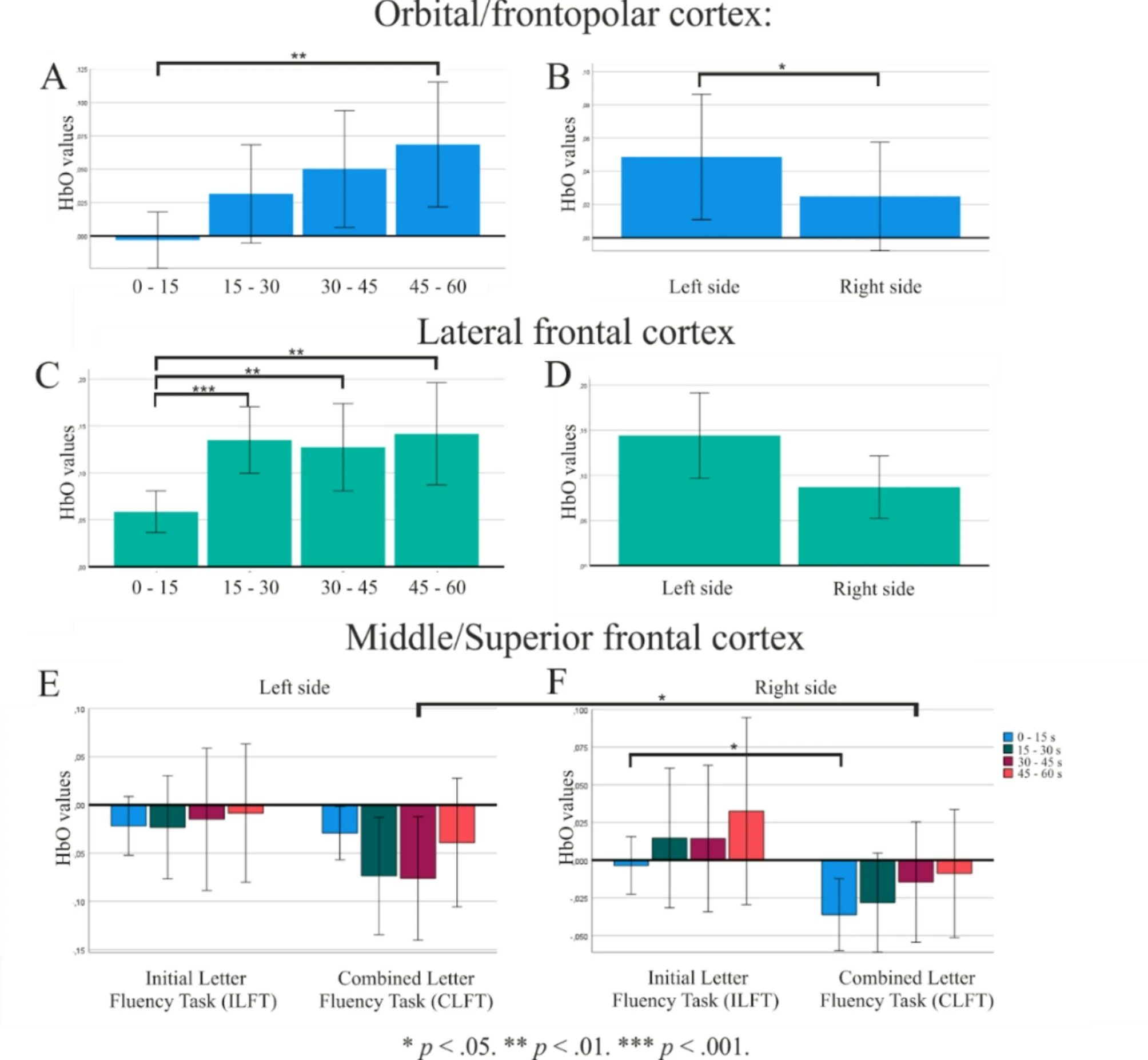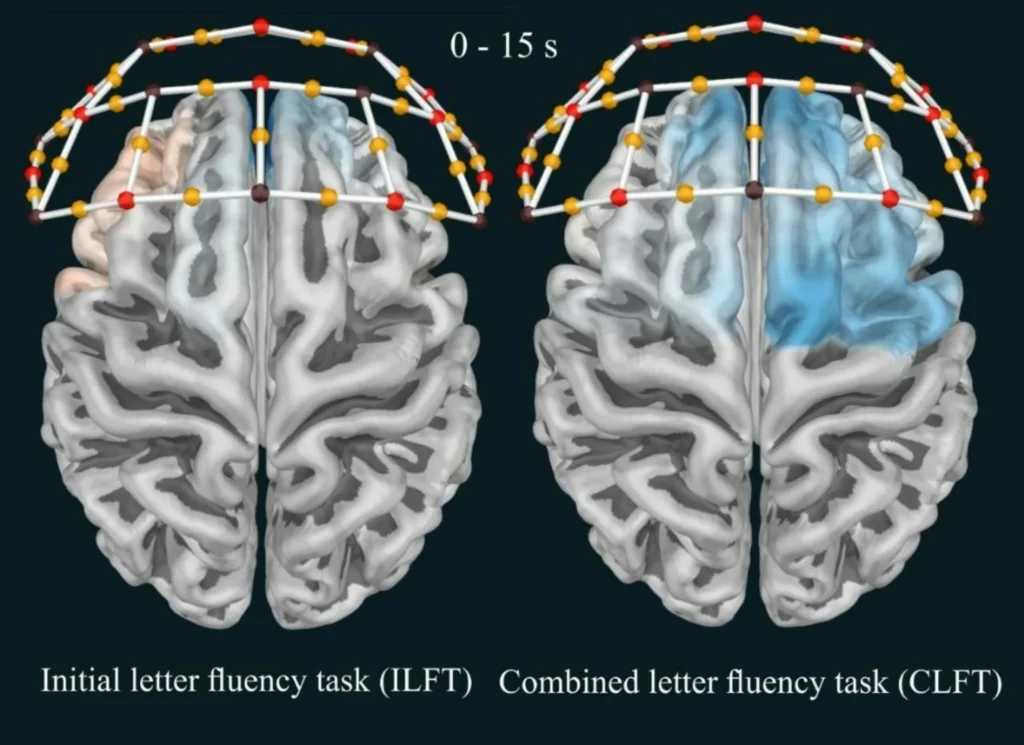A recent study by Krukow et al. (2025), published in Scientific Reports1 presented a comparative analysis of a Combined Letter Fluency Task (CLFT)—newly introduced version of the verbal fluency test (VFT)—and a typical Initial Letter Fluency Task (ILFT), using fNIRS technology for data obtaining and its further analysis.
Introduction
The verbal fluency tests (VFT) are widely used to study frontal cortex activity in clinical groups and cognitive neuroscience research. Traditionally, these tasks are analyzed using functional magnetic resonance imaging (fMRI), but there is growing interest in using fNIRS to measure oxygenated (oxy-Hb) and deoxygenated hemoglobin (deoxy-Hb) in brain tissue.
Krukow et al. (2025) implies that the interest in fNIRS is driven by ease of use, cost-effectiveness, and minimal requirements for specialized equipment or dedicated space. Portable fNIRS systems have shown the ability to produce data that correlates well with fMRI’s blood oxygenation level-dependent (BOLD) signals.
Commonly, VFTs are combined with fNIRS to study individuals with schizophrenia, depression, and bipolar disorder, as well as research on aging and dementia. These tests usually last up to 1 minute and are divided into phonemic fluency, focused on pronouncing words with particular letter(s) and semantic fluency – naming words within a particular category (animals, fruits etc). This division elicits hemodynamic responses in the corresponding brain regions involved in task performance.
Phonemic tasks engage the dorsolateral prefrontal cortex (DLPFC) for controlled retrieval, while semantic tasks involve the ventrolateral PFC and temporal regions for associative processing.
However, Krukow et al. (2025) consider that recent research has highlighted the limitations of standard VFTs. The cognitive and linguistic specificity of VFT remains unclear. Studies have shown that phonemic VFT activates the frontal cortex more strongly than semantic VFT. Moreover, factors such as processing speed, verbal intelligence, executive functioning, and education level significantly influence performance.
Combined Letter Fluency Task
According to Krukow et al. (2025), some alternations for VFTs have already been considered, such as picking words which did not contain a particular letter from an assigned category; or switching between two or more-word categories, which relied on cognitive flexibility and demanded more involvement of a working memory.
Since none of those modified verbal fluency tasks (VFTs) examined whether such tasks reveal any difference in patterns of frontal cortex activation compared to standard initial letter fluency tests (ILFT), Krukow et al. (2025) proposed a new task—the CLFT.
The purpose of the study was to observe dynamic changes in frontal cortex activity using fNIRS, aiming to detect behavioral and hemodynamic differences during two tasks—the CLFT and the traditional ILFT—and to compare their activation patterns. More about the study here.
Krukow et al. (2025) anticipated that CLFT would result in a lower number of correct responses, a higher error rate, and more irregular clustering and switching behavior, as well as the time-on-task curve (which tracks the number of words generated over successive time intervals) flatting for CLFT, reflecting a diminished reliance on automatic verbal associations, especially early in the task was expected.
The procedure
Participants
The study involved 35 participants, but only 32 were successfully evaluated due to signal artifacts in the fNIRS data from 3 participants, who were eventually excluded from the analysis.
All participants were adults, with an average age of 22.6 ± 2.8 years for females and 25.0 ± 6.1 years for males; all were Caucasian, had no recorded neurological disorders or chronic pain; all were based in Lublin (Poland, EU), where the study was conducted. Participation was voluntary and included established financial compensation.
Methods & Materials
According to Krukow et al. (2025), the procedure was conducted using a computer with pre-installed PsychoPy software (version 2023.2.3v79), specifically designed for this test, and a Photon Cap C20 fNIRS system, to measure brain activity.
Instructions and tasks were displayed on a monitor positioned at eye level to minimize downward head tilt during the examination. Spoken responses were digitally recorded and manually analyzed according to linguistic standards.
Participants completed two tasks:
- the traditional initial letter fluency task (ILFT) (5 rounds, 60 seconds each)—verbally generated as many words as possible beginning with a given letter, presented in a randomized order for each participant.
- the combined letter fluency task (CLFT)—similar to ILFT, except participants had to generate as many words as possible that began with a specific consonant, while avoiding a specific vowel.
Initially, half of the participants began with the ILFT procedure, while the other half started with the CLFT procedure. Each task session lasted less than 15 minutes.
The study was intentionally divided into two separate sessions spaced 7-8 days apart due to cognitive load and in order to control transfer effects.
Optical signals were recorded using a two-wavelength (760 and 850 nm) continuous-wave system, equipped with a 32-channel montage covering the forehead regions of each participant. The collected data, sampled at 5 Hz, was analyzed using CortiPrism software (v. 06.2023). Photon Cap recordings were first converted from raw intensity to optical density using the modified Beer-Lambert Law. Motion artifacts were subsequently corrected using the TDDR—Temporal Derivative Distribution Repair algorithm (as shown in Fig. 4 of the study report, based on CortiPrism data).
Fig. 4: Channel distribution and regions of interest (ROIs) analyzed in the frontal cortex, as visualized using CortiPrism software v.1.2.2).

Evaluation criteria
Krukow et al. (2025) considered responses correct if the participants followed the task instructions and if the produced words contained none of the following errors: repetitions, incorrect initial letters, use of proper nouns, or CLFT-specific vowel rule violations. Additionally, speech was examined for groups of words related by sound or meaning, and shifts between such groups, using phonetic and semantic criteria.
Results
Photon Cap C20 data analysis
Krukow et al. (2025) stated, that oxy-Hb concentration outcomes were analyzed with respect to task, time and lateralization, as well as their interactions across three distinct Regions of Interest (ROIs): orbital/frontopolar cortex (OFC), lateral frontal cortex (LF), and middle/superior frontal cortex (pre-SMA).
The changes in hemoglobin concentration within three ROIs was analyzed across four time segments: 0–15, 15–30, 30–45, and 45–60 seconds, using mixed-model repeated-measures ANOVA approach (2 task types * (4*15 sec consecutive intervals) (as shown in Fig. 1 of the study report).
Fig. 1: Task × Time-on-Task ANOVA results for CLFT and ILFT.

A repeated measures ANOVA method revealed (as shown in Fig. 2 of the study report):
- in the OFC region—the oxy-Hb concentration was highly time-reliant, showing a significant increase in the final 15 seconds of the task (45–60 sec) compared to the start (0–15 sec). The higher oxy-Hb concentration on the left side of the brain signaled a significant effect of lateralization. No other effects or interactions reached significance.
- in the LF region—similar to OFC, oxy-Hb levels were affected by time, since oxy-Hb significantly increased during both the 15–30 sec and 45–60 sec intervals compared to the initial 0–15 sec segment. Additionally, the oxy-Hb levels during the 30–45 sec interval were significantly higher than during the 0–15 sec interval. A main effect of lateralization was also found with higher oxy-Hb levels on the left side compared to the right, with no other main or significant effects.
- in the pre-SMA region—a significant interaction between time, task type, and brain lateralization was detected. Further contrastive analysis indicated a notable drop in oxy-Hb concentration on the right hemisphere during the 0–15 sec interval during the CLFT compared to the ILFT.
Fig. 2: Brain activity (oxy-Hb changes) over time and between left and right hemispheres in different frontal regions. Panels A–D show timing and lateralization effects; panels E–F compare two types of word fluency tasks (ILFT vs. CLFT). Results are statistically corrected for multiple tests.

Conclusion
The study aimed to examine how CLFT affects brain activity by comparing it to a standard phonemic fluency task. The analysis focused on differences in oxy-Hb response patterns between the two tasks, rather than comparing them to a baseline state.
While assessing the clinical utility of CLFT was not the primary objective, the results suggest that it may be a valuable tool for exploring cognitive selection processes and merits further investigation.
This demonstrates the reliability of our devices – such as Photon Cap—for accurate data acquisition and processing in experimental clinical studies. Ultimately, the data collected can support the ongoing development of improved methods for studying and visualizing brain activity.
- This blog post is based on open-access publication: Krukow, P., Kopiś-Posiej, N., Rodríguez-González, V. et al. Effects of the combined letter fluency task on frontal cortex regional and dynamic oxygenation patterns. Sci Rep 15, 26468 (2025). https://doi.org/10.1038/s41598-025-12558-7. ↩︎
